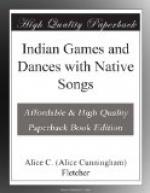When this signal is given, the members should toss their wands at the foot of the tree from the place where they had stopped dancing.
In the ancient Omaha ceremony the people had the vast expanse of the prairie at their disposal, yet each tribal group kept its appointed place, not only during the dance, wherein they made four approaches toward the sacred tree, but when all the groups formed into two great circles the tribal order of their relative positions was still preserved. The two circles were made up according to sex. The women and girls danced in one direction next to the pole; the men and boys formed the outer circle and danced in the opposite direction. This dance was the occasion of much hilarity and fun. Old and young danced with vigor, and great was the delight of the tribe as it spun around the emblematic tree, carrying branches. At the close of the dance all tossed the branches at the foot of the pole, leaving a mound of green on the widespreading plain.
If boys and girls take part, as they should, in this ceremony, let the girls form the inner circle and the boys the outer circle as they dance about the tree in true Omaha fashion.
In real Indian life every vocation has its accompaniment of song, no matter how homely may be the employment. So, keeping faith with that ancient American custom, let the camp be put in order after the ceremony while all sing the following song, which may be called the Clearing Up:
Song No. 5
THE CLEARING UP
[Music:
Now is our dancing ended,
Light are our hearts as our footsteps
Turn at our leaders’ bidding.
Safely we gather together
Branches that served our playtime,
Setting our camp all in order
Ere to our tents we betake us.]
This scene, in which all should take part, can be made merry as well as useful.
PART II
GAMES
INDIAN GAMES
INTRODUCTION.—All the games here presented have been played in our land for untold generations, while traces of the articles used for them have been found in the oldest remains on this continent. According to Dr. Stewart Culin, the well-known authority on Indian and other games, “There is no evidence that these games were imported into America at any time either before or after the conquest. On the other hand they appear to be the direct and natural outgrowth of aboriginal institutions in America.” Dr. Culin calls attention to the reference to games in the myths of the various tribes. Among those of the Pueblo people mention is made of the divine Twins who live in the east and the west, rule the day and the night, the Summer and the Winter, “Always contending they are the original patrons of play and their games are the games now played by men.”




